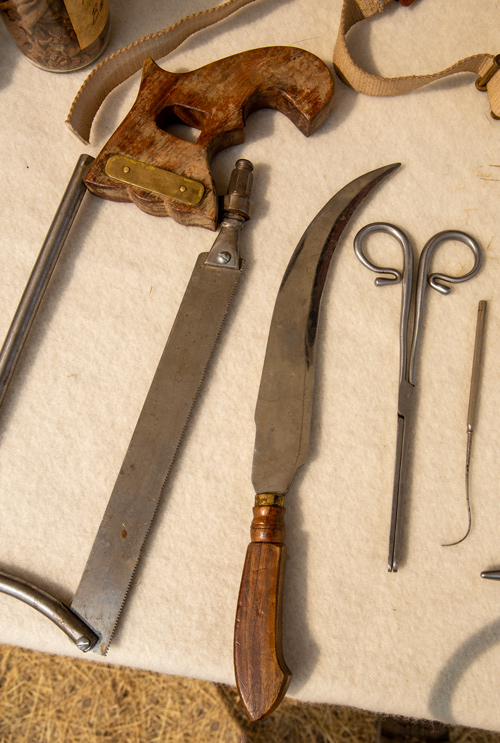At Fort Mandan below the Knife River Villages, Lewis amputates an Indian boy’s toes and bleeds one man to cure his pleurisy. Enlisted men either work to cut the boats out of the Missouri River ice or gather grass for the charcoal-making pile, and Toussaint Charbonneau brings in three North West Company horses.
An Amputation
by Yellowstone Public Radio[1]Originally aired weekdays by Yellowstone Public Radio during the Bicentennial observance of 2003-2006. Narrated by Hal Hansen. Scripts by Whit Hansen and Ed Jacobson. Produced by Leni Holliman. © … Continue reading
Amputation Saw
Historical interpretation by John W. Fisher and the Lewis and Clark Honor Guard. Photo © 2017 by Kristopher K. Townsend. Permission to use granted under the Creative Commons Attribution-Share Alike 4.0 International license.
Cutting Out the Boats
a fine day, attempt to Cut our Boat and Canoos out of the Ice, a deficuelt Task I fear as we find waters between the Ice,
—William Clark
Blood Letting and Amputation
I Bleed the man with the Plurisy to day & Swet him, Capt Lewis took of the Toes of one foot of the Boy who got frost bit Some time ago
—William Clark
Charcoal Pile
Some men employed Gitting hay from the prarie for to cover the Coal kill.
—John Ordway
North West Company Horses
Shabonoe [Charbonneau] our interpeter returned, & informed that the Assiniboins had returned to their Camps, & brough 3 horses of Mr. Laroches to Stay here for fear of their being Stolen by the Assiniboins who are great rogues—
—William Clark
Charb. & two men went off in the morning. Sent by them the 3 horses of the Co/ [North West Company] down to Fort Mandan, where Capt. Clarke told me, he would have them taken Care of, as there is so many Assiniboines.
—François-Antoine Larocque (26 January 1805)[2]W. Raymond Wood and Thomas D. Thiessen, Early Fur Trade on the Northern Plains: Canadian Traders among the Mandan and Hidatsa Indians, 1738–1818 (Norman: University of Oklahoma Press, 1985), 150.
Weather Diary
Ther. at rise
Weather Wind at rise
Thert. at 4 P.M. Weather Wind at 4 P.M. River 20 [above 0] cloudy S E 16 [above 0] cloudy N W raise 2 in. —Meriwether Lewis[3]To assist the reader, the editor of this web page has omitted the date column, merged the “River” columns, and spelled out some abbreviations.
Experience the Lewis and Clark Trail
The Lewis and Clark Trail Experience—our sister site at lewisandclark.travel—connects the world to people and places on the Lewis and Clark Trail.
Plan a trip related to January 27, 1805:

Fort Mandan is a High Potential Historic Site along the Lewis and Clark National Historic Trail managed by the U.S. National Park Service. The North Dakota Department of Parks and Recreation manages a modern reconstruction and the Lewis and Clark Interpretive Center located at US Hwy 83 and ND Hwy 200A.
Knife River Indian Villages National Historic Site is a High Potential Historic Site along the Lewis and Clark National Historic Trail managed by the U.S. National Park Service. A unit of the National Park System, the site is located at 564 County Road 37, one-half mile north of Stanton, North Dakota. It has exhibits, trails, and a visitor center.
Notes
| ↑1 | Originally aired weekdays by Yellowstone Public Radio during the Bicentennial observance of 2003-2006. Narrated by Hal Hansen. Scripts by Whit Hansen and Ed Jacobson. Produced by Leni Holliman. © 2003 by Yellowstone Public Radio. |
|---|---|
| ↑2 | W. Raymond Wood and Thomas D. Thiessen, Early Fur Trade on the Northern Plains: Canadian Traders among the Mandan and Hidatsa Indians, 1738–1818 (Norman: University of Oklahoma Press, 1985), 150. |
| ↑3 | To assist the reader, the editor of this web page has omitted the date column, merged the “River” columns, and spelled out some abbreviations. |



